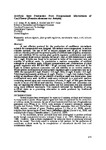The Production of Cauliflower Microshoots using Curd Meristematic Tissues and Hypocotyl–derived Callus.
| dc.contributor.author | Rihan, Hail | |
| dc.contributor.author | Al-Shamari, M | |
| dc.contributor.author | Fuller, MP | |
| dc.date.accessioned | 2013-01-28T14:01:41Z | |
| dc.date.available | 2013-01-28T14:01:41Z | |
| dc.date.issued | 2012-10 | |
| dc.identifier.issn | 0567-7572 | |
| dc.identifier.issn | 2406-6168 | |
| dc.identifier.uri | http://hdl.handle.net/10026.1/1265 | |
| dc.description.abstract |
The capacity for microshoot production from cauliflower was investigated applying two different protocols. In the first, cauliflower curd meristematic tissue was used as a source of explants. The meristematic layer was shaved off and the clusters produced were homogenised using a commercial blender. In terms of its effect on the number and viability of microshoots, the use of 30 s blending duration treatment was found to be optimal between several treatments tested in the range 15 to 120 sec. Explants were cultivated in agitated S23 (MS (Murashige and Skoog, 1962) + 3 % sucrose) liquid media supplemented with different combinations of plant growth regulators. The use of 2 mg/L kinetin and 1 mg/L IBA gave the optimal results in terms of the number and viability of microshoots. The second protocol was designed to investigate the regeneration potential of hypocotyl explants of cauliflower via callus culture. The callus tissue was initiated from hypocotyl explants in callus induction medium (CIM), which consisted of S23 supplemented with 2,4-D at 1 mg/L and kinetin at 1.5 mg/L. The highest number of shoots was obtained after 28 days from sub-cultured hypocotyl derived callus on S23 basal media containing 0.5 mg/L of kinetin. This study demonstrated the ability of producing microshoots using various parts of cauliflower through both callus and without callus formation which can be useful in the later applications of cauliflower tissue culture such as the production of artificial seeds. | |
| dc.format.extent | 427-434 | |
| dc.language | English | |
| dc.language.iso | English | |
| dc.publisher | International Society for Horticultural Science (ISHS) | |
| dc.subject | hyperhydricity | |
| dc.subject | meristimatic clusters | |
| dc.subject | induction | |
| dc.subject | viability | |
| dc.subject | media and plant growth regulator (PGR) | |
| dc.title | The Production of Cauliflower Microshoots using Curd Meristematic Tissues and Hypocotyl–derived Callus. | |
| dc.type | journal-article | |
| dc.type | Article | |
| plymouth.author-url | https://www.webofscience.com/api/gateway?GWVersion=2&SrcApp=PARTNER_APP&SrcAuth=LinksAMR&KeyUT=WOS:000323607700056&DestLinkType=FullRecord&DestApp=ALL_WOS&UsrCustomerID=11bb513d99f797142bcfeffcc58ea008 | |
| plymouth.issue | 961 | |
| plymouth.volume | 961 | |
| plymouth.publication-status | Published | |
| plymouth.journal | Acta Horticulturae | |
| dc.identifier.doi | 10.17660/actahortic.2012.961.56 | |
| plymouth.organisational-group | /Plymouth | |
| plymouth.organisational-group | /Plymouth/Faculty of Science and Engineering | |
| plymouth.organisational-group | /Plymouth/Faculty of Science and Engineering/School of Biological and Marine Sciences | |
| plymouth.organisational-group | /Plymouth/REF 2021 Researchers by UoA | |
| plymouth.organisational-group | /Plymouth/REF 2021 Researchers by UoA/UoA06 Agriculture, Veterinary and Food Science | |
| plymouth.organisational-group | /Plymouth/Users by role | |
| plymouth.organisational-group | /Plymouth/Users by role/Academics | |
| dc.identifier.eissn | 2406-6168 | |
| dc.rights.embargoperiod | Not known | |
| rioxxterms.versionofrecord | 10.17660/actahortic.2012.961.56 | |
| rioxxterms.licenseref.uri | http://www.rioxx.net/licenses/all-rights-reserved | |
| rioxxterms.type | Journal Article/Review |


